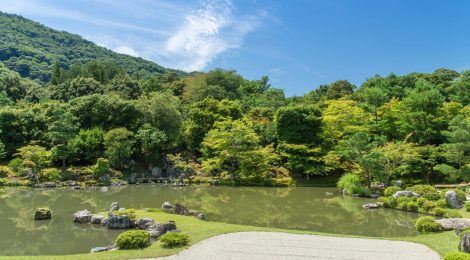
Tenryuji Temple
The garden of Tenryuji Temple is a magnificent testament to the combination of aristocratic tradition and Zen culture. Built in 1339, this temple complex was once comprised of over one hundred sub-temples, but today only a few structures remain. Despite the dwindling number of buildings, the main attraction of Tenryuji Temple lies in its garden, which is considered one of the finest examples of traditional Japanese garden design.
The first head of Tenryuji Temple was a renowned priest named Muso Soseki, who played a significant role in creating the garden. Muso Soseki designed the garden to reflect the changing seasons, with a large pond as its centerpiece. The garden also incorporates the surrounding landscape, utilizing the nearby hills of Kameyama and Arashiyama to enhance its composition. This technique, known as shakkei, is a common practice in Japanese garden design, where the natural surroundings are incorporated into the overall aesthetic.
Among the various gardens designed by Muso Soseki, the garden at Tenryuji Temple is believed to have undergone the least amount of change over the centuries. Its preservation and meticulous maintenance have allowed it to retain its original beauty, making it one of the most exquisite traditional landscaped gardens in japan.
One of the highlights of a visit to Tenryuji Temple is the Michelin-starred Shigetsu, a Zen vegetarian restaurant located within the temple grounds. This restaurant offers a unique dining experience, where visitors can enjoy a traditional vegetarian meal in a serene and peaceful setting. The menu is carefully curated to showcase the flavors of seasonal ingredients, further enhancing the connection between the garden and the dining experience.
In addition to the main temple and garden, there are also two sub-temples, Hogon-in and Kogenji, which are only open to visitors during specific times of the year, typically in spring and autumn. These sub-temples offer a glimpse into the religious and spiritual aspects of Tenryuji Temple, providing visitors with a deeper understanding of its rich history and cultural significance.
To reach Tenryuji Temple, visitors can take the Keifuku Line and get off at Arashiyama Station, which is just a two-minute walk away. The temple’s proximity to the station makes it easily accessible for tourists and locals alike.
It’s important to note that due to the ongoing COVID-19 pandemic, the information provided may be subject to change. It’s advisable to check for any updates or restrictions before planning a visit to Tenryuji Temple.
In conclusion, Tenryuji Temple and its garden are a testament to the rich history and cultural heritage of Japan. The combination of aristocratic tradition and Zen culture is beautifully reflected in the design and maintenance of the garden. Whether it’s the serene beauty of the garden, the spiritual experience of visiting the sub-temples, or the culinary delights at Shigetsu, a visit to Tenryuji Temple is a must for anyone interested in exploring the traditional aspects of Japanese culture.
Address And Maps Location:
68 Sagatenryujisusukinobaba-cho, Ukyo-ku, Kyoto-shi, Kyoto-fu
Subscribe, follow @idbcpr and idbackpacker.com